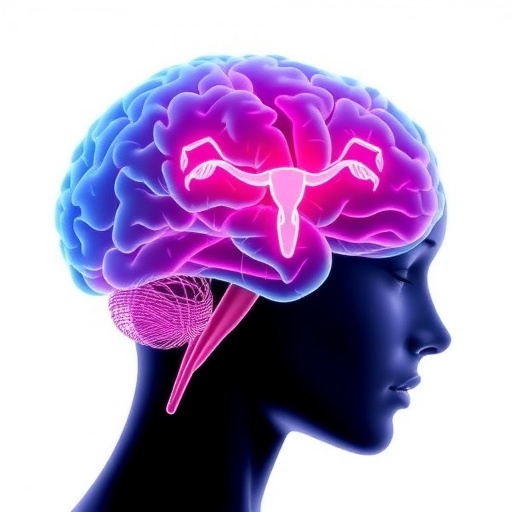The interplay between hormonal fluctuations and brain structure remains one of the most intriguing frontiers in neuroscience. Recent work by Heller, Güllmar, Colic, and their colleagues delivers groundbreaking insights by leveraging dense longitudinal brain imaging over the menstrual cycle in multiple individuals. This pioneering study captures whole-brain structural dynamics aligned with shifting hormonal milieus, unearthing profound implications for female brain plasticity and beyond.
Hormones have long been known to influence brain function and behavior—yet the precise timeline and magnitude of structural brain changes corresponding to endocrine shifts in the menstrual cycle have eluded direct observation. This is primarily due to challenges in high-frequency, within-subject imaging and the requirement for multi-modal analyses that bridge endocrinology and neuroimaging. The novel methodological design adopted in this study bridges these gaps, collecting repeated magnetic resonance imaging (MRI) measurements paired with hormonal assays in a dense sampling protocol over multiple cycles and subjects.
Employing advanced structural MRI techniques, the research team monitored whole-brain volumetric and morphometric changes in regions implicated in cognition, emotion, and sensory processing. Importantly, the study normalized these anatomical metrics against concurrent measurements of sex hormones, including estrogen and progesterone, capturing dynamic brain-hormone relationships on a timescale seldom achieved before. This approach uncovers fine-grained temporal patterns of brain plasticity reflective of the hormonal milieu, rather than static snapshots.
The findings reveal striking dynamic fluctuations in brain structure that correspond tightly with hormonal cycling. Certain brain regions exhibited volumetric increases during the follicular phase, when estrogen levels rise, while others contracted during the luteal phase, characterized by elevated progesterone. Notably, these structural changes were not isolated but engaged broad networks, underscoring the systemic influence of hormones on neural architecture. This delivers a paradigm shift from viewing female brain structure as static to recognizing it as a continually adapting system.
Beyond volumetric shifts, the work delves into subtle changes in cortical thickness and surface morphology. Regions involved in executive function, memory, and emotional regulation showed measurable modulations that tracked hormonal phases. These structural adjustments at the millimeter scale have profound implications for understanding cognitive and affective variability frequently observed across the menstrual cycle. The authors speculate that these neuroanatomical dynamics may underlie behavioral and psychological changes previously attributed to hormonal influences.
Importantly, this study goes beyond correlational observations by deploying rigorous statistical modeling, controlling for confounding variables such as hydration, circadian rhythms, and overall brain volume. Such robustness strengthens the argument for a causal linkage between endogenous hormone fluctuations and brain structural dynamics. This paves the way for deeper mechanistic explorations into how hormones mediate neuroplasticity through cellular and molecular pathways.
Moreover, the dense sampling design exemplifies the power of individualized longitudinal data, revealing that while common patterns exist, substantial inter-individual variability in brain-hormone coupling occurs. This personalized lens highlights the need to move beyond population averages towards precision neuroscience approaches. Tailoring clinical interventions to menstrual cycle phases or hormonal statuses may optimize efficacy for neurological and psychiatric conditions in females.
This body of work also opens avenues for investigating hormonal interventions and their impact on brain structure. Understanding how exogenous hormones such as contraceptives modulate these natural structural rhythms could provide crucial insights. Additionally, the study lays foundational knowledge for exploring hormonal influences across the lifespan, including puberty, pregnancy, menopause, and hormone replacement therapy.
From a technical standpoint, the integration of high-resolution neuroimaging with endocrine measures necessitated sophisticated protocols. Standard MRI processing pipelines were adapted to accommodate repeated within-subject measures, minimizing bias and enhancing signal detection sensitivity. Hormone assays were conducted with ultra-sensitive techniques to capture subtle hormonal oscillations, achieving unprecedented temporal resolution.
Future endeavors may expand upon these findings by coupling structural imaging with functional modalities such as fMRI and EEG to link hormonal structural dynamics with real-time brain activity and connectivity. Multi-omic approaches integrating transcriptomic and epigenetic data could further elucidate molecular correlates underlying anatomical plasticity. The multi-disciplinary nature of this research exemplifies the convergence needed in contemporary neuroscience.
The results resonate beyond academic curiosity. They bear clinical relevance for understanding female susceptibility to neurological disorders such as epilepsy, depression, and migraine, which exhibit cyclical symptomology linked to hormonal changes. Recognizing that brain architecture itself is plastic across the menstrual cycle offers novel biomarkers and therapeutic windows for such conditions.
Furthermore, these findings challenge the historically male-centric brain research paradigm. They underscore the necessity of incorporating sex as a biological variable in neuroimaging studies and clinical trials, to capture the complexity and richness of female neurobiology. The demonstration of ongoing structural brain adaptation in healthy young females reframes our understanding of the brain as dynamically attuned to internal physiological states.
Ethically and socially, this research advocates for increased awareness and destigmatization regarding female neurological health. Recognizing that cognitive and emotional variability linked to menstrual cycles is grounded in tangible brain structure changes validates lived experiences and fosters empathy in clinical and social contexts. Such insights could shape public health policies and educational curricula.
In sum, the study by Heller and colleagues represents a landmark advance in neuroscience by charting how the hormonal milieu orchestrates whole-brain structural dynamics across the menstrual cycle using dense, multi-subject sampling. Their integration of endocrinology and neuroimaging methodologies sets new standards for rigor and resolution, unveiling a rich neuroplastic landscape hitherto hidden. This transformative work electrifies discussions around brain plasticity, sex differences, and personalized neuroscience.
As the scientific community digests these findings, the exciting challenge now lies in translating these foundational insights into practical applications that improve women’s neurological health and cognitive wellness. The hormonal orchestration of brain structure demonstrated here offers a compelling vista of opportunity for future research and clinical innovation.
Subject of Research: Hormonal influences on whole-brain structural dynamics across the menstrual cycle.
Article Title: Hormonal milieu influences whole-brain structural dynamics across the menstrual cycle using dense sampling in multiple individuals.
Article References:
Heller, C., Güllmar, D., Colic, L. et al. Hormonal milieu influences whole-brain structural dynamics across the menstrual cycle using dense sampling in multiple individuals. Nat Neurosci (2025). https://doi.org/10.1038/s41593-025-02066-2
Image Credits: AI Generated




